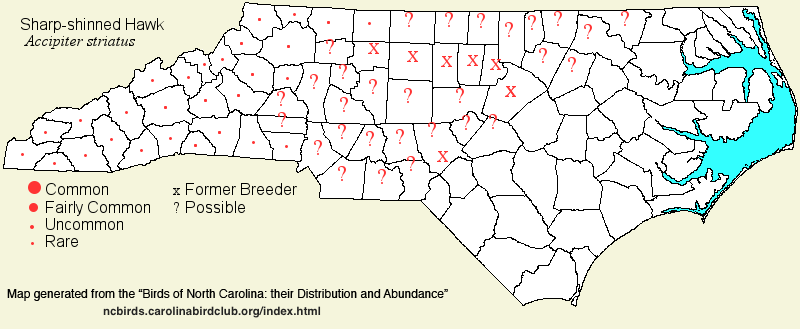 |  |
|
Sharp-shinned Hawk - Accipiter striatus ACCIPITRIDAE Members: | Search Common: Search Scientific: |
|
|
|||||||
| General Comments | The Sharp-shinned Hawk is the smallest of the three Accipiter species in the state and was, until the mid-2000's, the most frequently seen of the genus. However, it has suffered a continental population decline, presumably on the breeding grounds, and sightings of the Cooper's Hawk often outnumber Sharp-shinneds now in many areas. The species breeds primarily in Canada and the northern United States, though the breeding range does include the mountains and very sparingly the Piedmont of North Carolina to a limited extent. Sharp-shinneds do winter across the state, but highest numbers are seen in fall migration, both along the coast and along the mountains. The species nests in various forested habitats, typically interspersed with fields and other openings. And, at other seasons, this hawk also occurs where there is a mix of forests and fields, though it typically stays fairly close to cover and only infrequently perches in the open. Thus, most "Sharpies" are seen only in flight, where they are frequently confused with Cooper's Hawks. | ||||||
| Breeding Status | Breeder | ||||||
| NC BRC List | Definitive | ||||||
| State Status | SR | ||||||
| U.S. Status | |||||||
| State Rank | S2B,S4N | ||||||
| Global Rank | G5 | ||||||
| Coastal Plain | Migrant and winter resident, but declining in numbers; casual breeder in the extreme western portion. Fairly common to (formerly) common fall migrant only along the immediate coast, but normally only for a day or two after a strong cold front. Over most of the province, a fairly common fall migrant, fairly common winter resident near the coast and in Tidewater, and uncommon to fairly common in winter over the inner portion of the region. Since 2005, it has now become only uncommon to fairly common, at best, over most of the province. No obvious spring migration (i.e., little or no increase in birds noted in spring). Mainly from late Aug to early May. Breeding: apparently nested at Weymouth Woods Sandhills Nature Preserve (Moore) in 1999, and again from 2005-2007; also, there are scattered late May, Jun, and Jul records from the province that possibly could relate to locally breeding birds. Peak counts: 106, Cape Hatteras, 19 Oct 1993; | ||||||
| Piedmont | Migrant and winter resident, and scarce breeder, declining. Primarily an uncommon to (formerly) fairly common fall migrant, and uncommon winter resident (and in spring). Very rare to rare in summer, mainly in the western portions and foothills, breeding at least sporadically, east to the Fall Line (has nested in Wake). The species seldom nests in the same area from year to year, so it is difficult to assess population trends, though a few birds nest in the Piedmont each year. Primarily seen from late Aug to early May. Peak counts: 63 at a hawk migration site in the foothills, Pilot Mountain, 1 Sep 1987. | ||||||
| Mountains | Permanent resident, with migratory movements, declining. Fairly common (to occasionally common after a cold front) in fall migration, especially as noted from hawk watch sites; uncommon winter resident and in spring, and rare to (formerly) uncommon breeder; breeds at all elevations, though rare above 5,500 feet elevation. There are few actual breeding records, as finding nests is quite difficult. Notable was a nest containing two juveniles at Grandfather Mountain (Watauga), seen on 11 Jul 2024; and begging calls were heard coming from a presumed nest on Roan Mountain (Mitchell) on 19 Jul 2024. Another active nest was found at Mount Pisgah (Haywood) in Jul 2025. Most common in Sep-Oct. Peak counts: ?? | ||||||
| Finding Tips |
Accipiters can be difficult to target for observation, because habitat is abundant, and they can occur at any time, often just for brief glimpses. To intentionally look for Sharp-shinned, your best chance is along the immediate coast (barrier islands) on the first day in fall after a strong cold front. Hawk-watching sites in the mountains in Sep or Oct can be fairly good for seeing them. ** to *** | ||||||
| Attribution | LeGrand[2025-10-22], LeGrand[2024-11-04], LeGrand[2023-03-20] | ||||||
| NC Map Map depicts all counties with a report (transient or resident) for the species. | Click on county for list of all known species. |
| NC Breeding Season Map Map depicts assumed breeding season abundance for the species. |  |